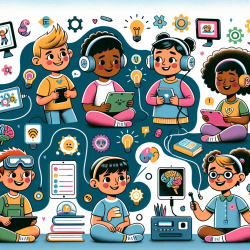Introduction
As speech-language pathologists, our role extends beyond the immediate therapeutic interventions we provide. We are often advocates for our clients, particularly children with disabilities, who may face stigma and its detrimental effects. A recent study, "Stigma of persons with disabilities in South Africa: Uncovering pathways from discrimination to depression and low self-esteem," provides valuable insights that can enhance our practice and advocacy efforts.
Understanding the Research
The study conducted in Soweto, South Africa, highlights the pervasive impact of stigma on individuals with disabilities. It reveals that stigma significantly mediates the relationship between disability and both depression and low self-esteem. This finding is crucial for practitioners, as it underscores the need to address stigma as part of our therapeutic approach.
Key Findings and Their Implications
- Stigma as a Mediator: The research demonstrates that stigma is not just a byproduct of disability but actively contributes to mental health challenges. This suggests that interventions must target stigma reduction to improve mental health outcomes.
- Impact on Mental Health: The study found a strong association between disability, depression, and low self-esteem, exacerbated by unemployment and low education. These findings highlight the importance of holistic approaches that address both educational and employment opportunities for individuals with disabilities.
- Need for Anti-Stigma Policies: The research calls for substantial psycho-social support and anti-stigma policies anchored in local cultural values. This is a critical area where speech-language pathologists can collaborate with policymakers to advocate for systemic changes.
Practical Applications for Practitioners
As practitioners, we can implement several strategies to mitigate the impact of stigma on children with disabilities:
- Promote Inclusive Practices: Encourage inclusive educational settings that foster acceptance and understanding among peers. This can help reduce stigma from an early age.
- Educate and Advocate: Use data-driven insights to educate parents, teachers, and the community about the effects of stigma and the importance of supportive environments.
- Collaborate with Stakeholders: Work with schools, community organizations, and policymakers to develop and implement anti-stigma programs that are culturally relevant and effective.
- Focus on Empowerment: Empower children with disabilities by building their self-esteem through positive reinforcement and by celebrating their achievements.
Encouraging Further Research
While this study provides valuable insights, further research is needed to explore the intersectionality of stigma with other factors such as gender, race, and specific types of disabilities. Practitioners are encouraged to engage in or support research efforts that deepen our understanding of these complex dynamics.
Conclusion
Addressing stigma is not just a moral imperative but a practical necessity to improve the mental health and overall well-being of children with disabilities. By integrating the findings of this study into our practice, we can contribute to breaking the cycle of exclusion and despair, fostering environments where all children can thrive.
To read the original research paper, please follow this link: Stigma of persons with disabilities in South Africa: Uncovering pathways from discrimination to depression and low self-esteem.










